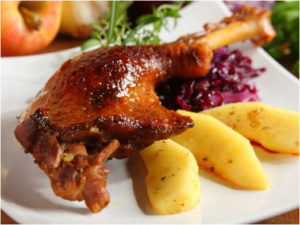“Who does not eat goose on Saint Martin’s Day, will be starving the following year.”
Hungarian Proverb
November 11th is Saint Martin’s Day, and this day is connected to several myths and traditions in Hungary. This is the time to finish the work on the fields, the beginning of Advent. The legend says, that Saint Martin tried to hide in a goose hutch, as he did not want to become a bishop, but the gooses’ betrayed him with their gaggling.
In the Roman times, November 11th was the first day of winter. People held a feast from the fresh harvest, and drank the new wine. Most of the time they ate goose, which was the bird of God Mars, that turned out to be Martin’s bird.
Saint Martin was highly appreciated in Pannonia (Roman name of the area where Hungary is situated). By the tradition, Saint Martin helped Saint Stephen, in his sleep, that made Saint Martin the second most important patron of Hungary, after Saint Maria.
Saint Martin’s day is the last holiday before advent, so this day was the day for celebrations, feasts and fairs. No cleaning, washing was allowed to do on this day, because this kind of work would hurt the animals, ( a good excuse for feasting instead of work actually). In November, the “force fed” goose could already been cut, this time of the year we particularly eat lots of goose dishes, such as: goose soup, roasted goose leg with dumplings and sauerkraut, or goose liver. It was a custom to send the “back part” of the goose to the bishop, that is why this particular part of the animal is called “püspökfalat” (“bishop’s bite”).
Several restaurants serve traditional (or non-traditional) goose dishes, goose liver for Saint Martin’s Day. Enjoy, and do not forget to try the new wine following the fabulous bites!

